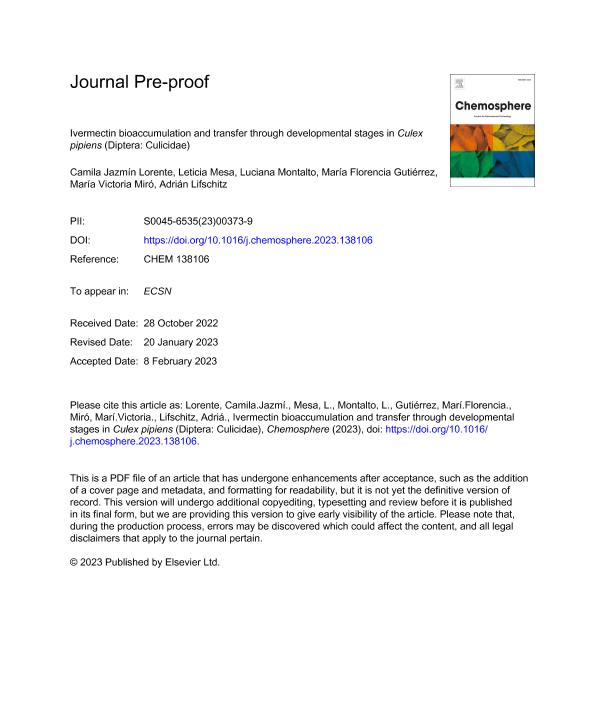Mostrar el registro sencillo del ítem
dc.contributor.author
Lorente, Camila Jazmín

dc.contributor.author
Mesa, Leticia Mariana

dc.contributor.author
Montalto, Luciana

dc.contributor.author
Gutiérrez, Florencia María

dc.contributor.author
Miró, María Victoria

dc.contributor.author
Lifschitz, Adrian Luis

dc.date.available
2024-02-27T11:10:02Z
dc.date.issued
2023-05
dc.identifier.citation
Lorente, Camila Jazmín; Mesa, Leticia Mariana; Montalto, Luciana; Gutiérrez, Florencia María; Miró, María Victoria; et al.; Ivermectin bioaccumulation and transfer through developmental stages in Culex pipiens (Diptera: Culicidae); Pergamon-Elsevier Science Ltd; Chemosphere; 322; 5-2023; 1-31
dc.identifier.issn
0045-6535
dc.identifier.uri
http://hdl.handle.net/11336/228496
dc.description.abstract
Ivermectin (IVM), one of the most widely used antiparasitics in livestock, could enters into the aquatic environment because the treated animal metabolizes only a small percentage of what is administered and the rest is eliminated through the feces, largely as a parent drug, imposing a risk to aquatic organisms. The aims of this study were to (1) assess the effect of IVM spiked in cattle dung on the survival and emergence of Culex pipiens (Diptera: Culicidae), and to (2) evaluate the accumulation of this drug in the different developmental stages of this taxon. Larvae were exposed to two IVM concentrations (T1: 1000 ng g−1 and T2: 500 ng g−1) for 9 days. At days 3, 6 and 9 survival and adult emergence were recorded and samples of larvae, pupae, pupal exuviae and adults were taken to analyze the IVM accumulation. At these concentrations, a reduction in survival and adult emergence of C. pipiens was recorded. In addition, the IVM accumulation was observed in all samples analyzed, decreasing it throughout the development of this taxon (larvae > pupae > adults). Although a large proportion of the drug was lost during the metamorphosis, being mainly eliminated through pupal exuviae during molting, this process is not enough to eliminate it completely. Thus, part of the drug was transferred to the adult stage and remains available to the aquatic and terrestrial food webs. These results show that IVM represents a risk to aquatic invertebrates and their predators, which deserves further studies, especially in the context of their bioaccumulation and biomagnification through the aquatic and terrestrial trophic webs.
dc.format
application/pdf
dc.language.iso
eng
dc.publisher
Pergamon-Elsevier Science Ltd

dc.rights
info:eu-repo/semantics/openAccess
dc.rights.uri
https://creativecommons.org/licenses/by-nc-sa/2.5/ar/
dc.subject
ANTIPARASITIC
dc.subject
AQUATIC-TERRESTRIAL LINKAGES
dc.subject
BIOACCUMULATION
dc.subject
CATTLE DUNG
dc.subject
DIPTERAN EMERGENCE
dc.subject.classification
Otras Ciencias Naturales y Exactas

dc.subject.classification
Otras Ciencias Naturales y Exactas

dc.subject.classification
CIENCIAS NATURALES Y EXACTAS

dc.title
Ivermectin bioaccumulation and transfer through developmental stages in Culex pipiens (Diptera: Culicidae)
dc.type
info:eu-repo/semantics/article
dc.type
info:ar-repo/semantics/artículo
dc.type
info:eu-repo/semantics/publishedVersion
dc.date.updated
2024-02-02T15:07:08Z
dc.journal.volume
322
dc.journal.pagination
1-31
dc.journal.pais
Estados Unidos

dc.description.fil
Fil: Lorente, Camila Jazmín. Consejo Nacional de Investigaciones Científicas y Técnicas. Centro Científico Tecnológico Conicet - Santa Fe. Instituto Nacional de Limnología. Universidad Nacional del Litoral. Instituto Nacional de Limnología; Argentina
dc.description.fil
Fil: Mesa, Leticia Mariana. Consejo Nacional de Investigaciones Científicas y Técnicas. Centro Científico Tecnológico Conicet - Santa Fe. Instituto Nacional de Limnología. Universidad Nacional del Litoral. Instituto Nacional de Limnología; Argentina
dc.description.fil
Fil: Montalto, Luciana. Consejo Nacional de Investigaciones Científicas y Técnicas. Centro Científico Tecnológico Conicet - Santa Fe. Instituto Nacional de Limnología. Universidad Nacional del Litoral. Instituto Nacional de Limnología; Argentina. Universidad Nacional del Litoral. Facultad de Humanidades y Ciencias; Argentina
dc.description.fil
Fil: Gutiérrez, Florencia María. Consejo Nacional de Investigaciones Científicas y Técnicas. Centro Científico Tecnológico Conicet - Santa Fe. Instituto Nacional de Limnología. Universidad Nacional del Litoral. Instituto Nacional de Limnología; Argentina. Universidad Nacional del Litoral. Facultad de Bioquímica y Ciencias Biológicas. Escuela Superior de Sanidad; Argentina
dc.description.fil
Fil: Miró, María Victoria. Consejo Nacional de Investigaciones Científicas y Técnicas. Centro Científico Tecnológico Conicet - Tandil. Centro de Investigación Veterinaria de Tandil. Universidad Nacional del Centro de la Provincia de Buenos Aires. Centro de Investigación Veterinaria de Tandil. Provincia de Buenos Aires. Gobernación. Comision de Investigaciones Científicas. Centro de Investigación Veterinaria de Tandil; Argentina
dc.description.fil
Fil: Lifschitz, Adrian Luis. Consejo Nacional de Investigaciones Científicas y Técnicas. Centro Científico Tecnológico Conicet - Tandil. Centro de Investigación Veterinaria de Tandil. Universidad Nacional del Centro de la Provincia de Buenos Aires. Centro de Investigación Veterinaria de Tandil. Provincia de Buenos Aires. Gobernación. Comision de Investigaciones Científicas. Centro de Investigación Veterinaria de Tandil; Argentina
dc.journal.title
Chemosphere

dc.relation.alternativeid
info:eu-repo/semantics/altIdentifier/url/https://linkinghub.elsevier.com/retrieve/pii/S0045653523003739
dc.relation.alternativeid
info:eu-repo/semantics/altIdentifier/doi/http://dx.doi.org/10.1016/j.chemosphere.2023.138106
Archivos asociados
